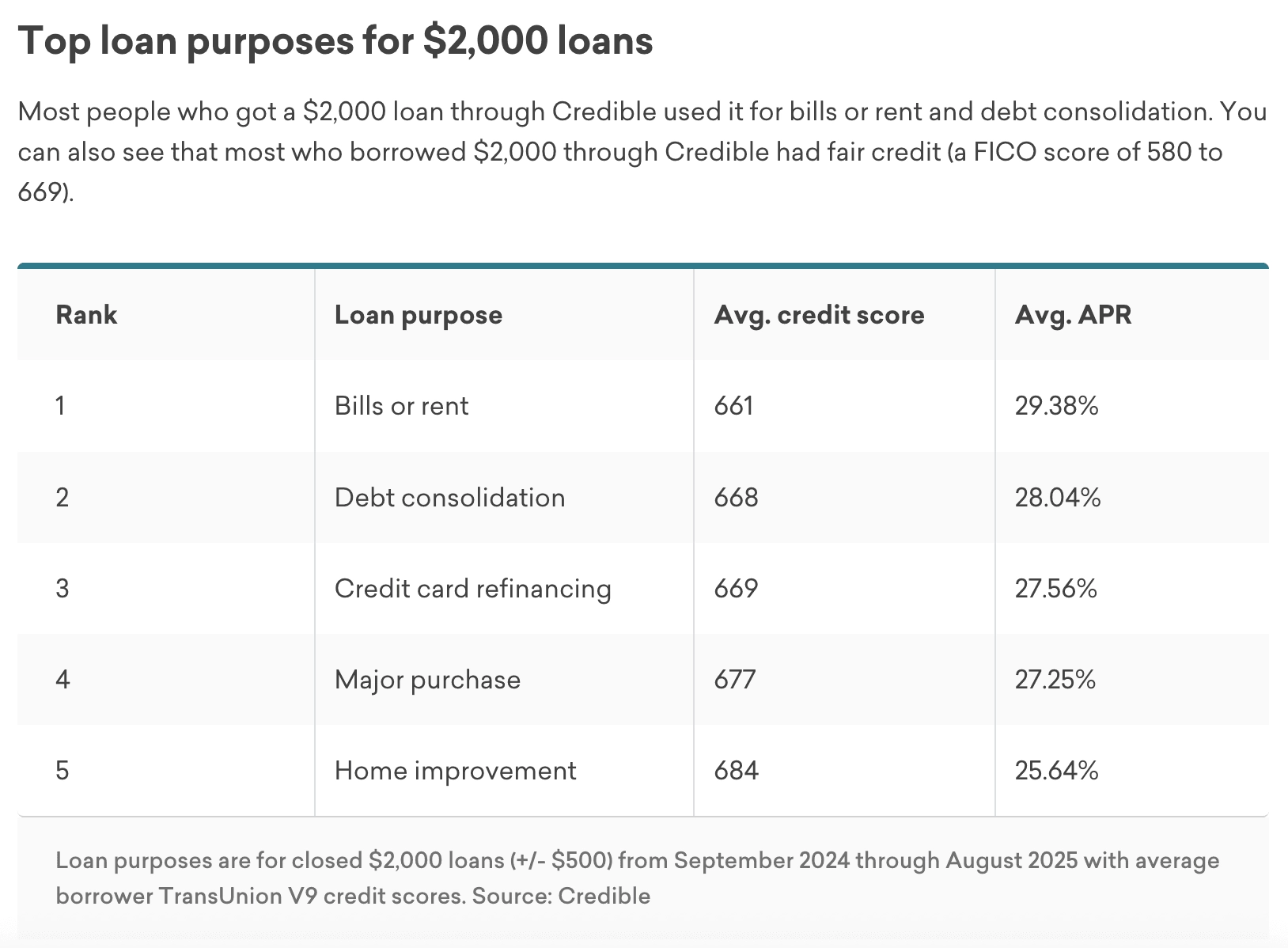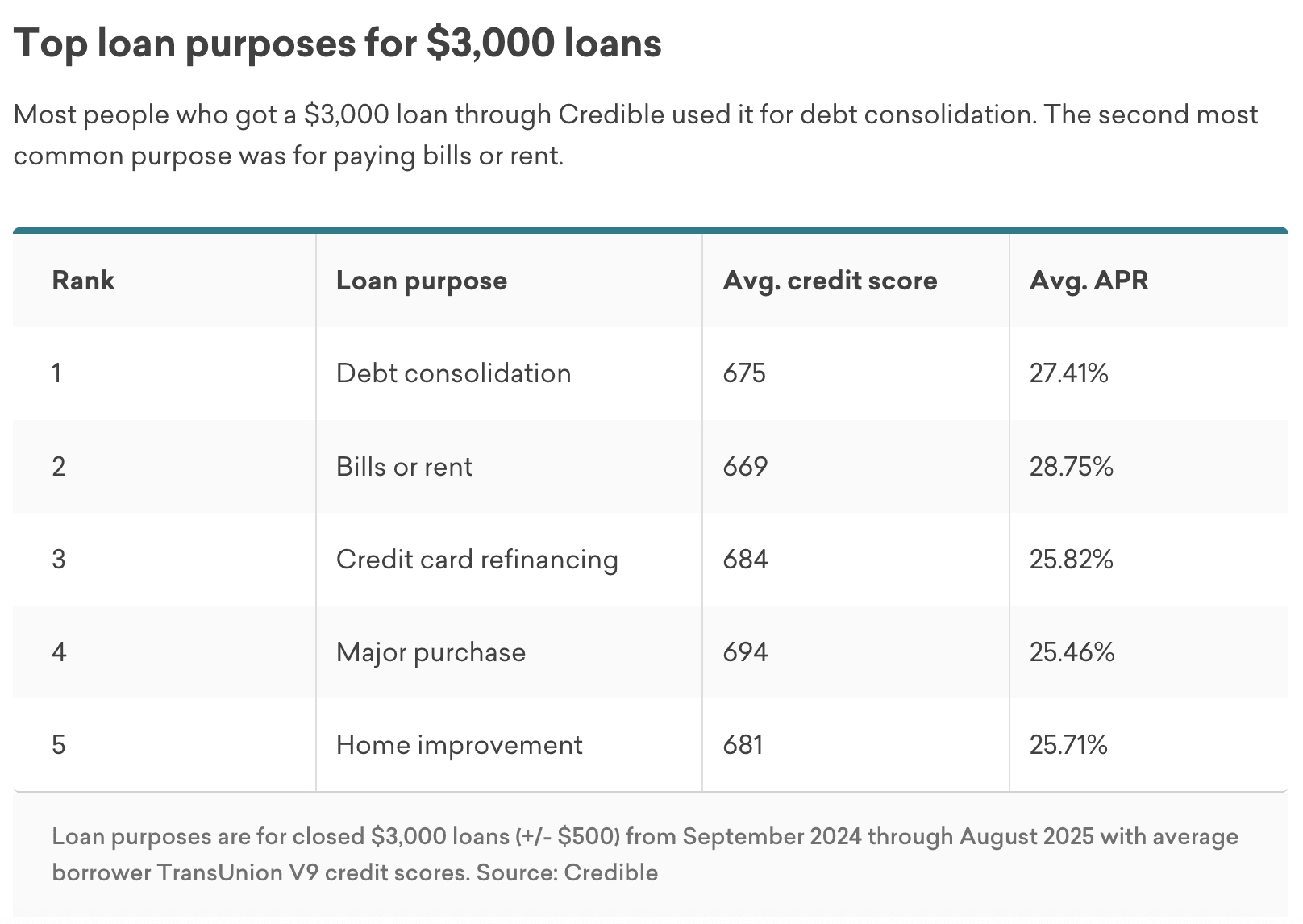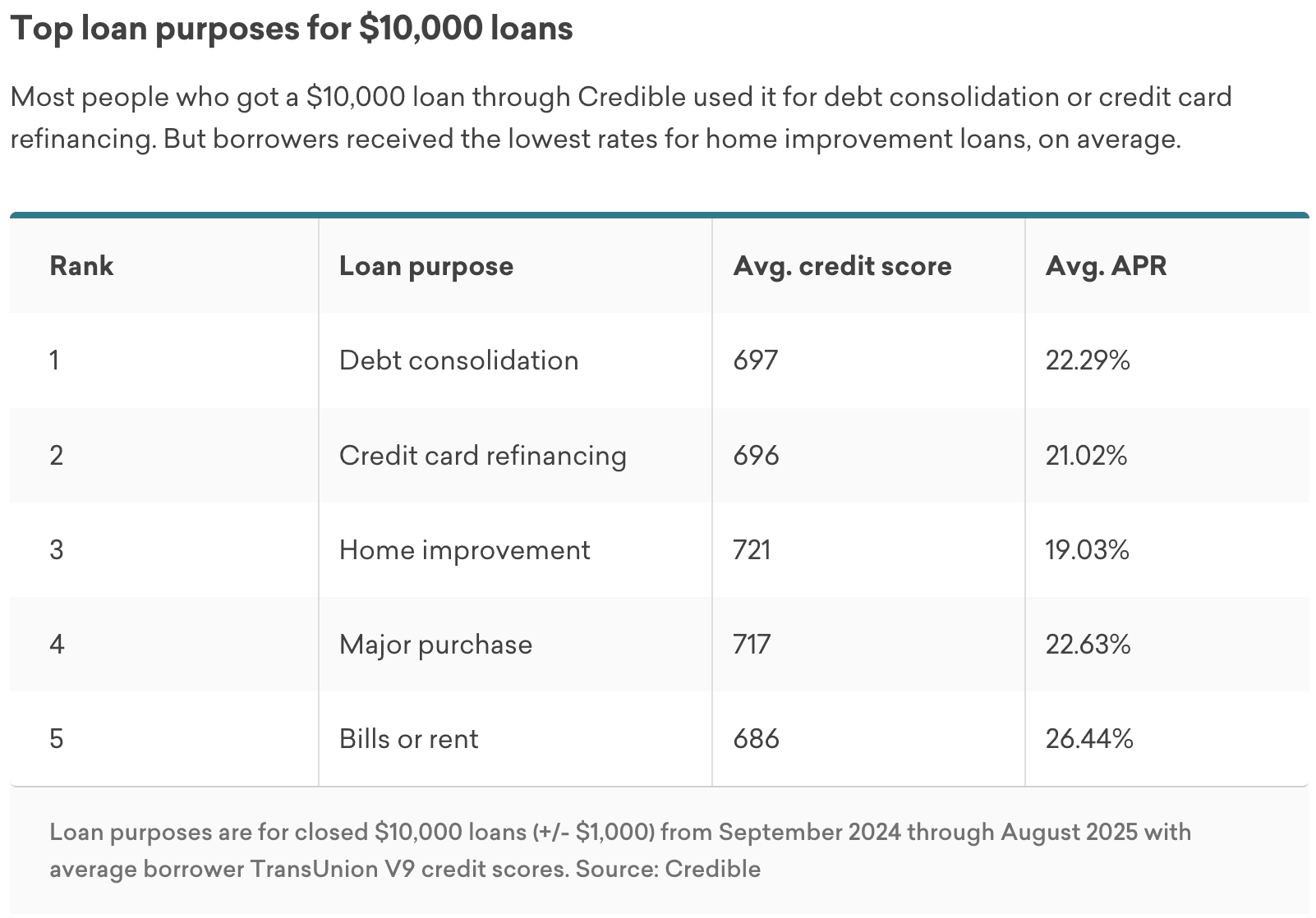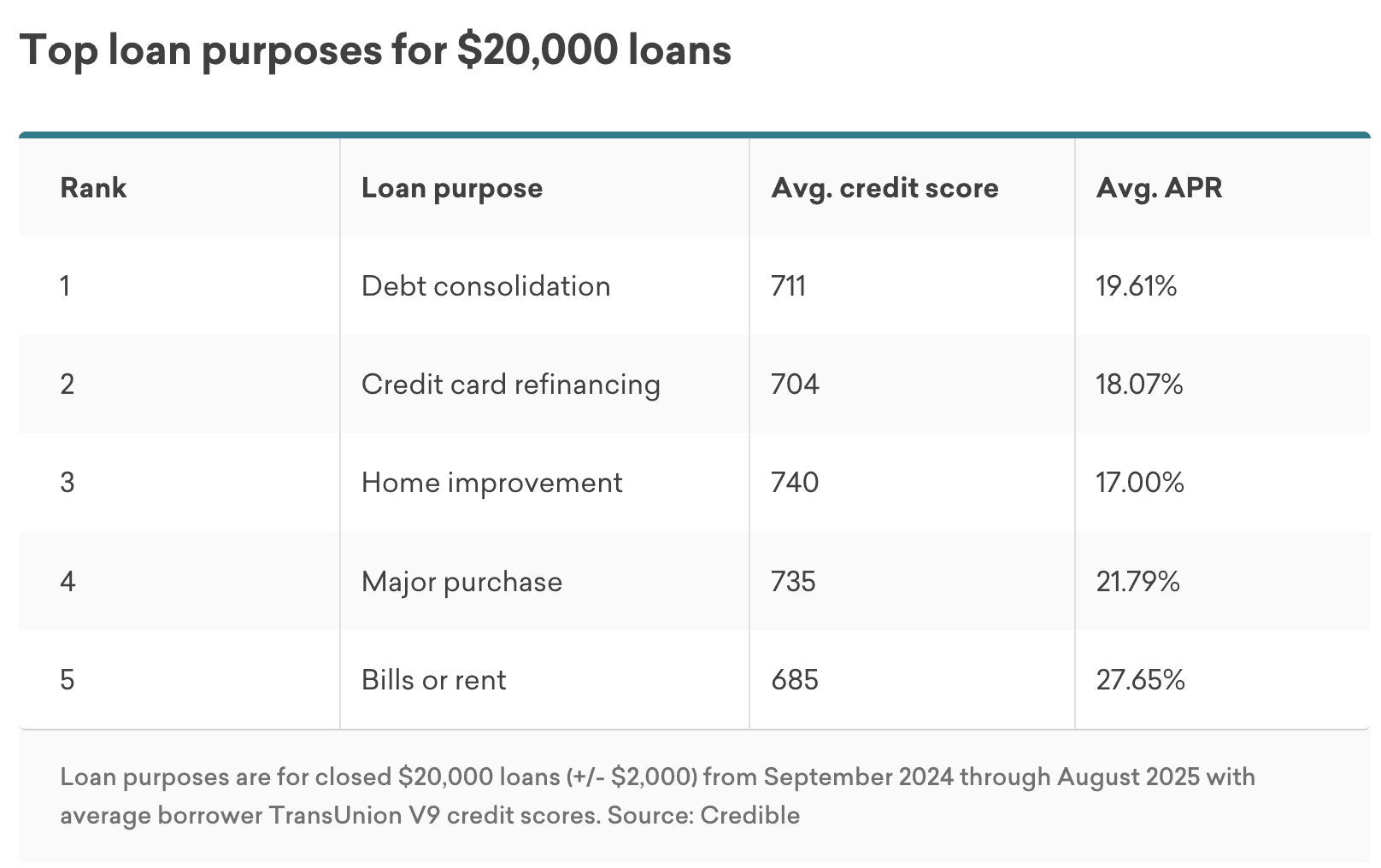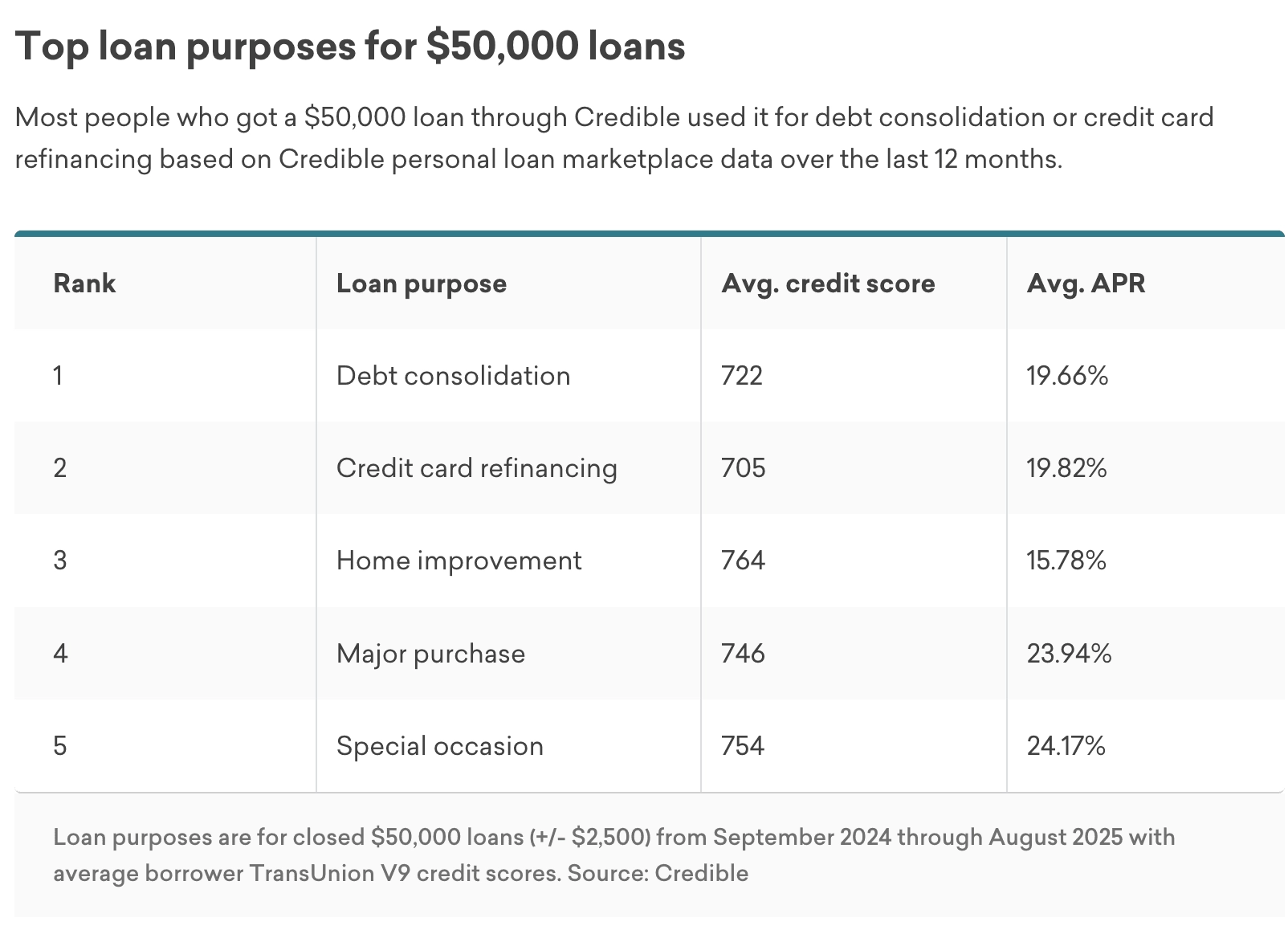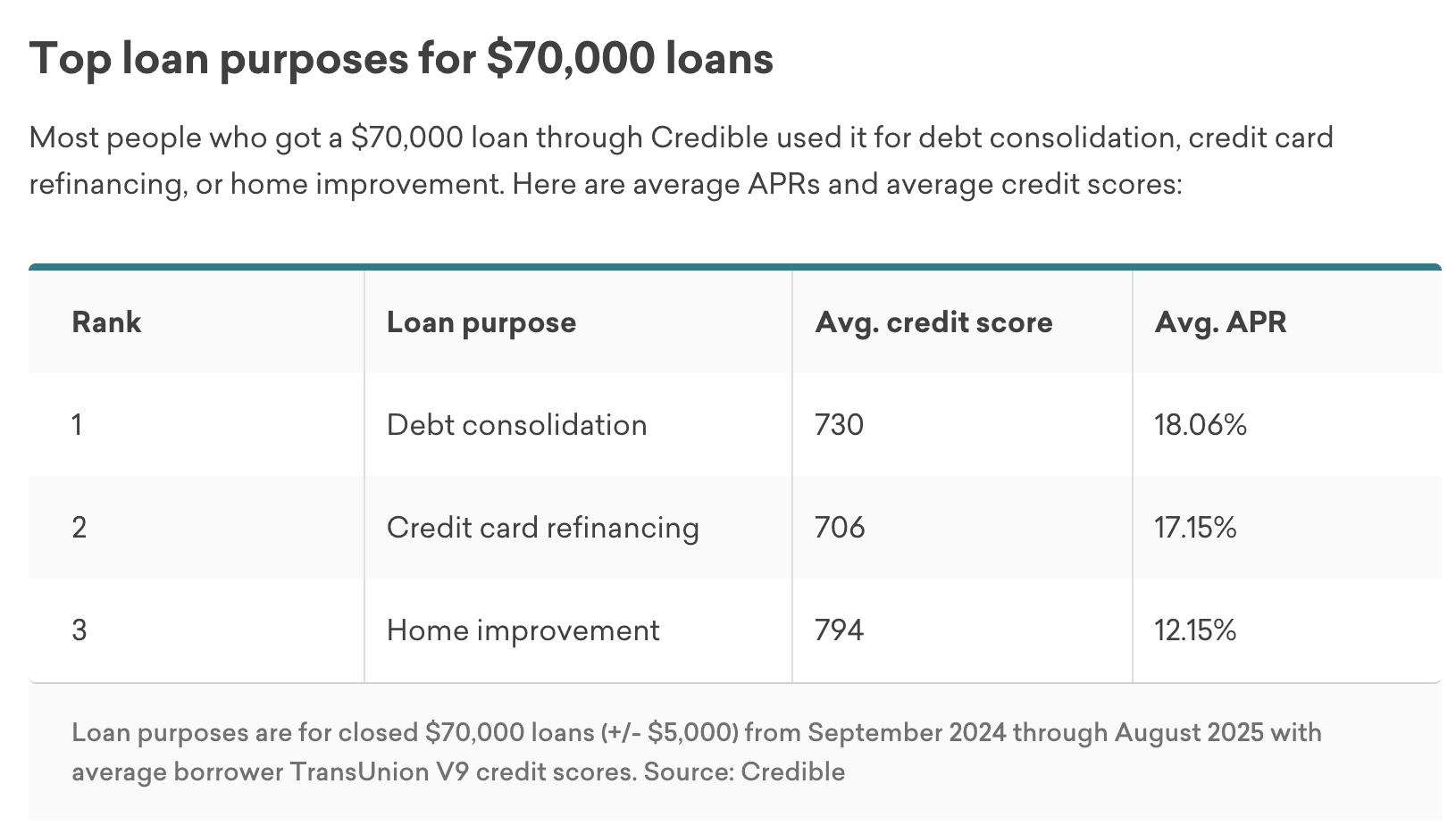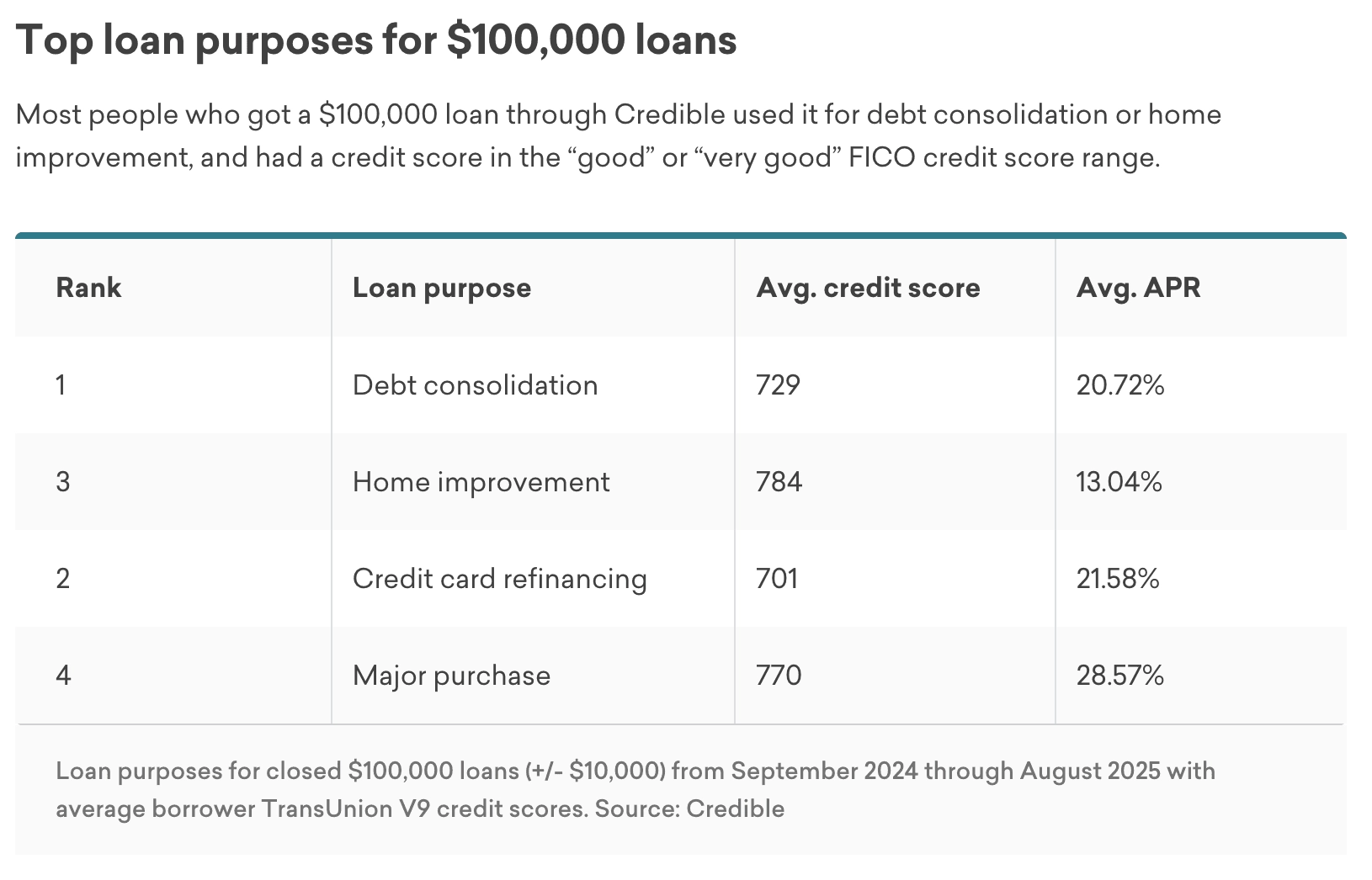Personal loan interest rates and demographic trends can reveal a lot about the state of consumer debt and spending. What are people using debt for? How much are they paying to borrow? How much are they borrowing? How have borrowing trends changed over time? We analyzed 12 to 24 months of data from the Credible personal loan marketplace from 19 lenders across more than $1.3 billion in closed loans to evaluate these questions and more.
Credible takeaways
- Higher credit scores generally lead to larger loan amounts and lower interest rates. Conversely, lower credit scores result in smaller loan amounts and higher rates.
- Homeowners with mortgages in California and Texas, earning $90,000+, are most likely to seek and prequalify for personal loans.
- Debt consolidation is the most common reason for obtaining a personal loan, followed by credit card refinancing and home improvements.
- Paying bills or rent is the top loan purpose for loans of $2,500 and less.
- Higher incomes tend to correlate with lower interest rates, even independent of credit score.
- Credit score is the strongest indicator of loan approval — borrowers with excellent credit have nearly a 90% chance of approval, while those with poor credit have less than a 1% chance.
- Certain loan purposes, like wedding loans and loans for home improvement, experience trends in seasonality.
Average personal loan interest rates
This section details average personal loan interest rates, broken down by historical trends, credit score, loan purpose, and income.
Historic personal loan interest rates
The following chart illustrates how personal loan interest rates for three- and five-year loans can vary over time. Like other consumer loan rates, personal loan rates generally track the federal funds rate. This is why rates were lowest in 2022 when the effective federal funds rate was under 1%. For reference, as of October 1, the effective federal funds rate was 4.09%.
Read More: The Fed's Effect on Personal Loan Rates Explained
Personal loan rates by credit score
Most lenders have a range of rates they can apply to personal loans — often from under 10% APR to 35.99% APR — to accommodate different levels of risk they're willing to take on. Since credit scores are one of the most important indicators of risk, there's generally an inverse relationship between credit score and APR.
In addition to credit scores, you can see that the loan's term also impacts a loan's APR. Loans with shorter repayment terms tend to carry lower interest rates across the credit score spectrum.
Note: The chart above is based on prequalified rates for borrowers over the past month. It does not include rates for borrowers with bad credit (FICO scores <580) as there are too few loans closed for that group on a monthly basis to be statistically significant.
Free Credit Score: Check your credit score for free with Credible's credit-monitoring tool.
Average APRs by loan purpose
Average interest rates for different loan uses can vary substantially — from below 20% for home improvement loans to nearly 30% for loans to pay bills or rent. The differences in average interest rates can reflect that different types of borrowers (with different credit score profiles and annual incomes, for example) seek different types of loans. And that some loan purposes — like loans to pay bills or rent — may be more risky for lenders than others.
Interest rates for top loan purposes by credit score
This chart presents a more granular view of the chart above. Instead of overall averages, we can see average rates for each loan type broken down by credit score. Rates can vary significantly within the same credit score tier for different loan purposes — this insight could be applied strategically by borrowers to save money on interest.
For instance, a borrower with good credit contemplating a major purchase (average rate of 24.37%) might consider putting it on a credit card instead and then refinancing their credit card debt with a personal loan (average rate of 18.18%).
As expected, rates for all loan types increase as credit scores decrease.
Personal loan interest rates by income (& average credit scores)
Income is a key factor influencing interest rates and can compensate for a middle-of-the-road credit score.
Borrowers with higher incomes tend to qualify for lower interest rates and higher loan amounts. And though there's generally a correlation between average annual incomes and average FICO scores, the data suggest that having a higher income can help you get a lower interest rate, independent of your credit score.
For instance, there's little difference between credit scores for these two income tiers: $40,000 — $59,999 and $20,000 — $39,999. Yet, there's an almost 3 percentage point difference between average interest rates.
Disclosure: Based on Credible closed loans data from December 2024 through November 2025. Source: Credible
Top user profiles
People apply for personal loans nationwide and use the Credible personal loans marketplace to do so. But certain demographic groups are more likely to seek a personal loan than others. We found that:
- Most likely to seek and prequalify for a personal loan: Homeowners with a mortgage and annual incomes of $90,000 or more from California and Texas pursuing debt consolidation.
- Next most likely group to seek and successfully prequalify: Renters in California, also pursuing debt consolidation, with incomes above $60,000.
- Largest demographic looking for a personal loan: Renters in California with incomes above $40,000; though they were less likely to qualify than the prior two groups.
User profiles are based on 12 months of closed loans data and prequalification data, from September 2024 through August 2025.
Loan purposes
We looked at the percentage of borrowers seeking each type of loan as well as the average amounts borrowed for each purpose. Interestingly, loan purposes vary somewhat by credit score and loan amount.
Top loan purposes
Credible's lending partners offer personal loans for a wide range of uses. In order, the top reasons borrowers get a personal loan on the Credible marketplace are to:
- Consolidate debt
- Refinance one or more credit cards
- Make home improvements
- Make a major purchase
- Pay bills or rent
While debt consolidation and credit card refinancing are considered two different loan purposes, they're both used to pay off existing debt. More than half the personal loans taken out over the last year (65%) were used to pay off debt.
Average loan amounts for top loan purposes
Not only is debt consolidation the most popular reason to get a personal loan, debt consolidation loans are the largest personal loan types over the past year. We expect this is, in large part, because debt consolidation doesn't increase a borrower's overall debt burden and can reduce monthly payments.
Top loan purposes by credit score
Debt consolidation is also the most popular reason to get a personal loan across the credit score spectrum. Credit score refinancing is the second most common loan purpose, but not with excellent credit borrowers, who more commonly use personal loans to finance home improvements.
More borrowers with poor and fair credit take out personal loans to pay for bills or rent — making it the third most common loan purpose for both categories.
Top loan purposes by loan amounts
Here's what we discovered when we looked at the most common loan purposes for different loan amounts:
- Debt consolidation and credit card refinancing dominate across nearly every loan amount tier.
- Paying bills or rent is the top reason people borrowed $2,500 or less; it's the second- and third-top loan purpose for $3,000 loans and $5,000 loans, respectively.
- Home improvement becomes a top-3 purpose for $10K loans and above.
Top loan purposes for $2K
Top loan purposes for $3K loans
Top loan purposes for $10K loans
Top loan purposes for $20K loans
Top loan purposes for $50K loans
Top loan purposes for $70K loans
Top loan purposes for $100K loans
Seasonality
Analysis of Credible personal loans data indicates that certain personal loan purposes are more or less common during certain times of the year. For instance:
Wedding loans
- Tend to surge in January and continue through March, April, and May
- Tend to slump after June, briefly ticking upward in September and October
Home improvement loans
- Tend to surge from March through July
- Tend to reach their low point in the winter months
Some seasonal trends don't come as a surprise. For example, an increase in home improvement loans would coincide with the “renovation season” of the warmer spring and summer months. The reason wedding loans surge in January is because more people get engaged in December than in any other month, according to online wedding and planning service Zola. Once the holiday season is over, newly engaged couples presumably turn their attention to planning their upcoming weddings (which includes planning how to pay for them).
Analysis is based on data from closed loans covering the period of September 2023 through August 2025.
Average loan amounts
Not surprisingly, borrowers with higher credit scores also tend to qualify for higher loan amounts. This is, in part, because loan amounts are determined by the size of the monthly payment. The better your credit, the lower your rate, the lower your monthly payment. In other words, you can borrow more for the same monthly payment amount compared to someone with a lower credit score.
Average personal loan amounts by credit score
Disclosure: Based on loans that closed through the Credible personal loan marketplace from September 2024 through August 2025. Source: Credible
Personal loan approval estimates
Personal loan approval is multifaceted. But your credit score is the largest indicator of whether you're likely to be approved for a loan. We considered a year's worth of prequalification data to determine how likely borrowers are to get approved, based on their credit score alone. We also looked at average interest rates across each credit score band based on approved loans.
We found that borrowers with excellent credit (800 FICO scores and higher) have an almost 90% chance of getting approved for a loan, while borrowers with poor credit (FICO scores below 580) have a less than 1% chance.
Approval estimates by credit score
Disclosure: Data are for Credible marketplace users from September 2024 through August 2025; % prequalified represents those who successfully prequalified for a loan. Source: Credible
Note: Approval estimates are based on the percentage of people who were able to prequalify for a loan, which is not an offer of credit and does not guarantee an offer will be extended.
Methodology / Where we get our data
Credible is a personal loans marketplace that partners directly with 19 lenders to offer loans for a wide range of credit profiles and loan purposes. Because of these relationships, we have access to current personal loan trends and data based on real-time approvals and borrower activity. We also have access to historic rate data, along with rate data by credit score, loan purpose, and loan amount, approval rates overall and by lender, and more. The data we use is primary source data, updated monthly or weekly, and does not include any personally identifiable information about borrowers.
